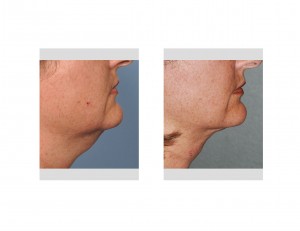While the neck is technically not part of the face, it makes a very important contribution to one’s appearance. The concept of the ideal neck shape is one that has a near 110 degree cervicomental angle. This helps highlight the jawline and makes a clear transition between the two.When the neck is more obtuse it may be the result of too much fat, loose or saggy skin or a combination of both.
How to reshape the full or obtuse neck requires an understanding of why it looks the way it does. As a general rule, younger patients have a greater contribution of too much fat with skin that still has good elasticity. Older patients (depending upon how you want to define older) may also have significant fat but the diminishing quality of the skin’s elasticity and how much it sags become contributing factors as well.
Many neck contouring treatments are available that range from non-surgical (light, infrared or ultrasound), minimally invasive (threadlifts) or actual surgical procedures such as liposuction and different forms of necklifts. The degree of effectiveness of any of these neck procedures depends on how well the treatment changes the amount of fat in the neck, tightens the skin or preferably does some of both. When the patient’s problem matches what the treatment does best, an improved neck shape will occur. If not, results will be poor.
One potential neck contouring treatment is liposuction. As the only known treatment method that can remove fat, it is no surprise that it is a part of almost any surgical neck procedure. A basic principle of liposuction, anywhere on the body, is that the skin must retract afterwards. Part of its reshaping effects relies on the skin shrinking down to the reduced understructure. What is unique in neck liposuction is that the skin must actually shrink upward which is a bit more of a skin redraping challenge.
While traditional liposuction does not have any direct effects on creating skin tightening, that has changed with the use of Smartlipo or laser liposuction. The heat created by the melting of fat and the ability to run the fiberoptic probe along the underside of the skin can create a effect on his collagenous structure. This creates the potential for better skin retraction and some degree of actual tightening.


Dr. Barry Eppley
Indianapolis, Indiana


